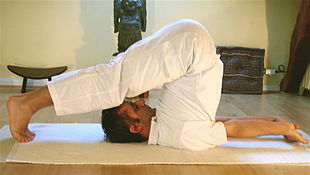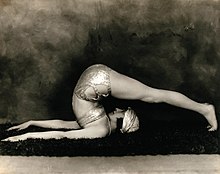Halasana

Halasana (
. Its variations include Karnapidasana with the knees by the ears, and Supta Konasana with the feet wide apart.Etymology and origins


The name Halasana comes from Sanskrit हला hala, "plough" and आसन āsana, "posture" or "seat".[2] The pose is described and illustrated in the 19th century Sritattvanidhi as Lāṇgalāsana, which also means plough pose in Sanskrit.[3]
Karnapidasana is not found in the medieval
Description
The pose is entered from Sarvangasana (shoulderstand), lowering the back slightly for balance, and moving the arms and legs over the head until the outstretched toes touch the ground and the fingertips, in a preparatory variant of the pose. The arms may then be moved to support the back into a more vertical position, giving a second variant pose. Finally, the arms may be stretched out on the ground away from the feet, giving the final pose in the shape of a traditional plough.[4][7][8][9]
Variations

Karnapidasana (ear-pressing pose) or Raja Halasana (royal plough pose) has the knees bent close to the head and grasped by the arms.[10]
Parsva Halasana (sideways plough) has the body vertical, the trunk twisted to one side, and legs out straight with the feet touching the ground (to that side).[10]
Supta Konasana (supine angle pose) has the legs as wide apart as possible, the toes on the ground, like an inverted
All these variations may be performed as part of a cycle starting from Sarvangasana (Shoulderstand).[10]
See also
References
- ^ Anon (28 August 2007). "Plough Pose". Yoga Journal.
- ISBN 978-0-949027-03-0.
- ^ Sjoman 1999, p. 72.
- ^ a b Iyengar 1979, pp. 216–219.
- ^ Sjoman 1999, pp. 88, 92.
- ISBN 978-81-7041-293-9.
- ISSN 0191-0965.
- ISBN 978-1-58736-033-6.
- ISBN 978-1-58736-708-3.
- ^ a b c d Mehta 1990, pp. 111–115.
- ^ "Supta Konasana". Yogapedia. Retrieved 8 February 2019.
Sources
- ISBN 978-1855381667.
- Mehta, Silva; Mehta, Mira; Mehta, Shyam (1990). )
- ISBN 81-7017-389-2.



